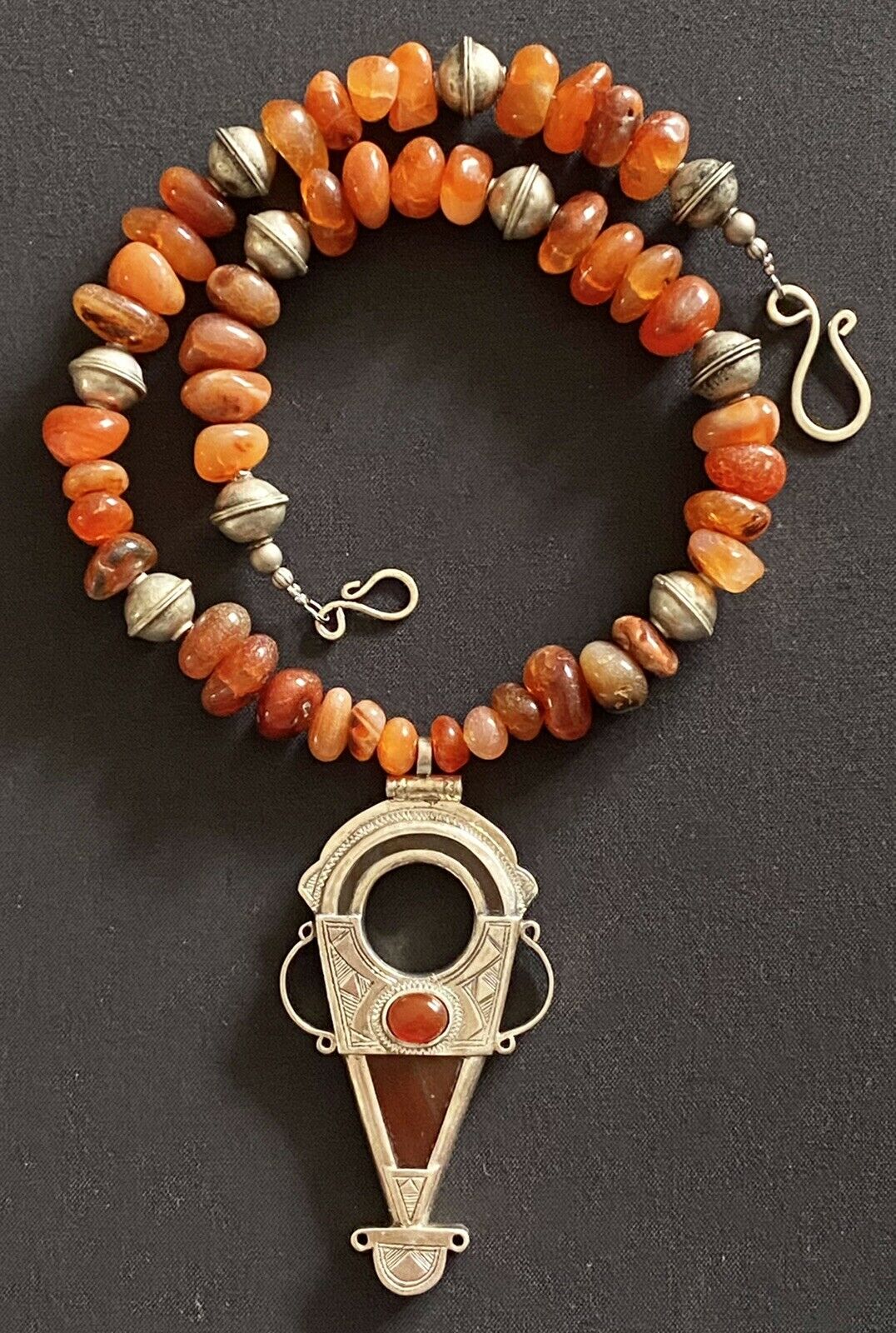-40%
Talhakimt Moroccan carnelian old silver pendant berber Tuareg Handmade necklace.
$ 138.86
- Description
- Size Guide
Description
Talhakimt carnelian silver pendant Antique Moroccan handmade vintage bohemian necklace with ancient old trade Carnelian beads from Africa and silver tribal Bicone beads.Shipped via first class usps mail.
Talhakimt Tuareg Beaded berber tribal pendant with huge talhakimt silver Carnelian gemstone pendant measuring 3.75” in height by 2” in width.
This Marrakech necklace is truly one of a kind and will make a great addition to your collection.
The Tuareg talhakimt carnelian pendant was made in Morocco by local artisans and has a cabochon carnelian 10mm gemstone in the center.
The graduated old trade African carnelian vintage collection beads measure approximately 16mm down to 10mm.
This is an old authentic Moroccan handmade silver beaded unique necklace.
Genuine old Carnelian gemstone beads.
The 10 Moroccan silver bicone beads measure approximately 16mm and are imported from Morocco North Africa.
Finished with a Large Bali style hook clasp closure.
The necklace is 22” inches in length.
Handmade unique vintage piece.
Carnelian is said to aid health, long life and good fortune. It is also said to help one fulfil ones innermost wishes if worn near the heart. Warming and cleansing the blood and kidneys this stone works well in the orange and yellow. This stone can also be used to stimulate appetite, passion, emotions and physical energy.
Talhakimt pendants were produced by both the French and Czech-Bohemian bead industries during the trade bead era, which peaked between the late 19th and early 20th centuries. The Czech versions were made from molded glass, and came in a variety of colors, including green, red and blue.
French Talhakimts were the brainchild of Jean-Felix Bapterosses, a pioneering button and bead maker. As a young man, Bapterosses traveled to England, where he studied the “Prosser” technique of molding and firing a paste to produce a hard porcelain-like material. Bapterosses returned to France and, after making several improvements to the technique, implemented it at his button and bead factory in Briare.
Talhakimt pendants were one of the many items manufactured at the factory.
French Talhakimts, along with their Czech-Bohemian counterparts, were exported mainly to West Africa, where they were believed to have amuletic properties. Mauritanian women wore them in elaborate headdresses, plaited into long braids.
The most spectacular examples of this kind of adornment were found among the dancers of the Guedra, a traditional dance in which women displayed their love for men in ritual form.
Talhakimt pendants such as this were exported to West Africa for the bead trade throughout the course of the 20th century. Originally produced in the bead workshops of Bohemia from Czech Glass, they were molded using the Prosser method and coveted by tribal peoples as a talisman to ward off the evil eye and as part of traditional costumes. This is an original piece. Get your piece of history today!
Berbers call themselves some variant of the word i-Mazigh-en (singular: a-Mazigh), possibly meaning "free people" or "noble men". The name probably had its ancient parallel in the Roman and Greek names for Berbers, Mazices.
The berber language (Tamazight) is one of the oldest languages of humanity. Nowadays, it is spoken by the people of North Africa , Egyptian oasis of Siwa and the Touaregs in the Sahara (desert).
From Central Atlas Tamazight ⴰⵎⴰⵣⵉⵖ (amaziɣ). From the active participle ⴰⵎ (am) and ⴰⵣⵉⵖ (aziɣ), whose meaning is unknown but is possibly related to "aze" ("to be strong" in Taznatit), or perhaps "jeɣeɣ" ("to be brave" in Tamasheq); z and j frequently swap out in The Berber are the indigenous people of North Africa, west of the Nile Valley. Many Berbers call themselves some variant of the word Imazighen(singular: Amazigh), possibly meaning "free people" or "free and noble men". The word has probably an ancient parallel in the Roman name for some of the Berber, "Mazices".
The name Berber comes from the name given to this people by the Romans, meaning barbarians. The history of the Berber people in northern Africa is both extensive and diverse. Their oldest ancestors settled in the East of Egypt.


















